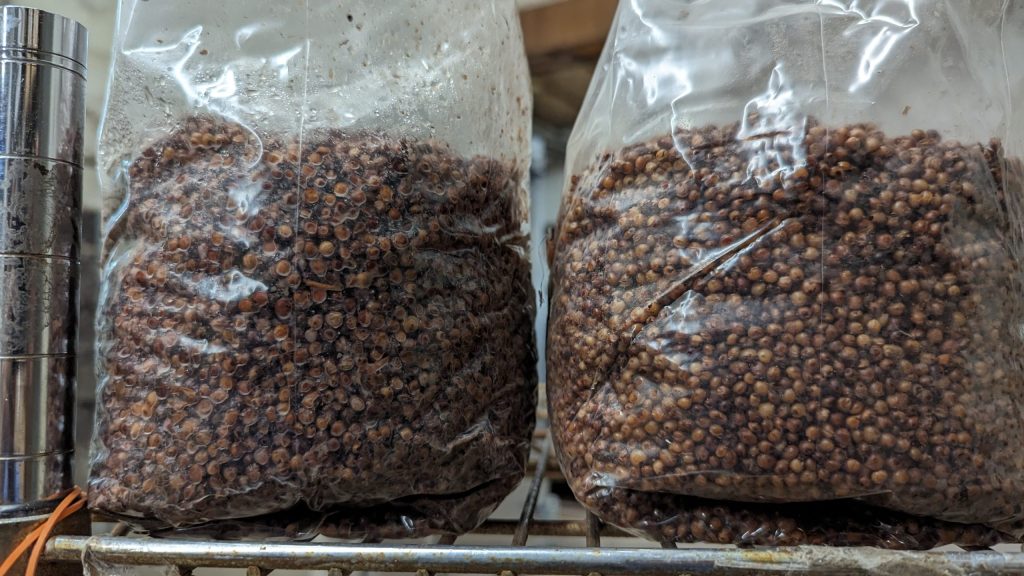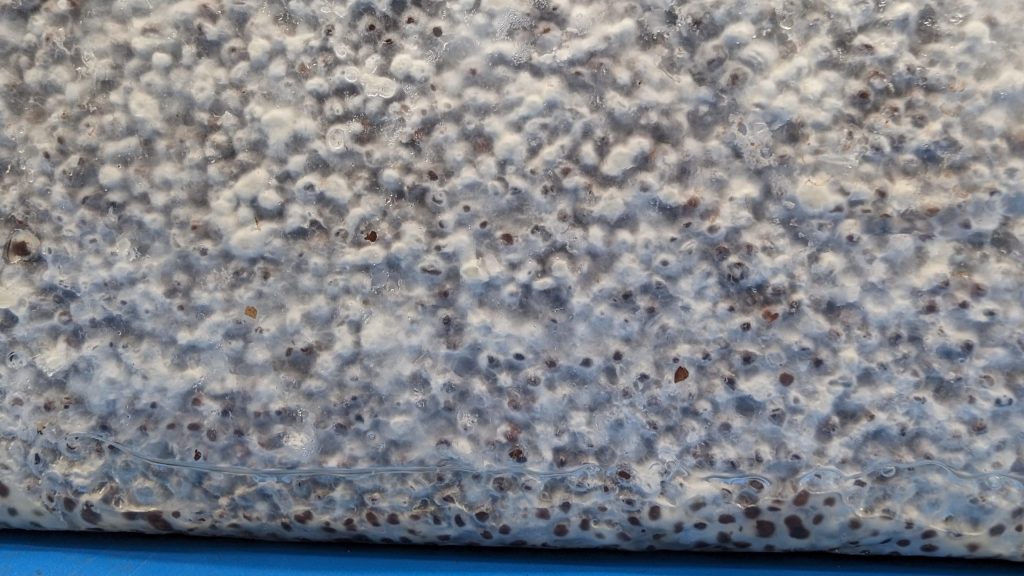there are a few types of contamination: bacterial, mold and yeasts. Understanding why you got a contamination in the first place can help you prevent it in the future.
Bacterial Contamination
appearence:
bacteria will appear as wet spots, but not just any wet spot. It will be milky and runny. Water can form from condensation and it will be clear. Clear condensation isn’t contamination, just an artifact of the bag. Rarely you may also find starch that has been released from the grain

Left: bag is severely contaminated with a bacteria that produces heat resistant endospores. Notice the milky runny liquid that forms crescent moon 🌙 shakes towards the ground: this is bacteria that has settled in the droplets of water that form as it degrades the starches.
Right: sterile grain. Notice it is dryer but what moisture is present is clear and clean.

Above is an image of grain spawn that has colonized as well as accumulated a significant amount of water at the bottom. This water is crystal clear and a good sign the spawn is not contaminated with bacteria.
smell:
Bacteria will smell very off putting: sour is the smell that first comes to mind, or like the
Behavior:
Bacteria will degrade the starch in the grain which holds onto moisture. Mushroom mycelium and other organisms will also do this, but often these fungi are growing additional structures that can hold onto or utilize the water released better. Bacteria however seem to get suspended in the released water and float around with it, so the free water content in the bag will rise as the bacteria takes over and degrades the starches.
Causes
Bad Inoculant:
Bacteria tends to occur either from bad inoculant that has the bacteria present, such as a spore syringe, LC syringe or already bad grain spawn that had bacteria present unbeknownst to the person inoculating the grain.
Improper Sterilization
If it is not due to contaminated inoculant, it is from improper sterilization of the grain itself. Most simple heat treatments will quickly destroy the spores or actively growing forms of molds, fungi, and yeast as well as the actively growing forms of bacteria. However bacterial endospores are suprisingly heat resistant thanks to the stabilizing agent dipicolinic acid which makes up 15% of their structure. . As most bacteria isn’t spread via particles in the air, tends not to
Mistreatment of gas exchange filters
More true with liquid cultures than spawn bags, but a wet filter patch that isn’t hydrophobic can fail and transfer bacteria into your substrate. This is common with homemade filters for liquid cultures, such as when micropore tape or tyvek is used. Unicorn Bags or other filter patch bags for mycological purposes tend to handle direct liquid contact better as they seem to have a filter made from hydrophobic layers of polyproplyene and teflon (PTFE), with very small pore sizes.
Mold
appearance:
dust, fiber like structures, mycelium of different texture or structure, colors of white, green, red, black, brown, gray and tan.
smell:
Unlike a bacteria, or yeast these won’t have nearly as much smell, but they will have some mild differences from an otherwise fully sterilized bag of grain. Likely if the mushroom mycelium is growing, the smell of the mushroom will overpower the scent of most any molds.
Behavior:
Molds spread both by mycelium and by producing more spores rapidly. You may at first see it in a small localized area but if agitated it will likely spread its spores to other places within the bag.
Causes:
Generally mold spores are easily and rapidly killed by heat, such as pasturizaton. So if you are getting a mold contamination, it is either from your inoculation or a failing component of the bag.
If you inoculated a bag of sterilized grain with a syringe, and the mold is growing where the liquid inoculant went; you likely introduced the mold by using a bad inoculant.
If the bag is not inoculated or it’s growing in a completely separate location, it is likely the bag has failed. The three most common ways are as follow:
1. Improperly attached or damaged filter patch. Improperly attached filters are fairly common due to the highly inert material the filter is made of as it doesn’t seal well with the plastic of the bag. This is often easly detected by squeezing the bag when it is inflated with air; if it rapidly loses its’ air with minimal resistance, check the filter. Alternatively there can be manufacting defects or other damages from handling that can add pin holes into the filter patch. A pin hole may seem small to us, but it’s a wide open door for many spores like trichoderma which have can a spore as small as 0.5 micron.
2. Improper seal
An improper seal can form many ways and be deceptive. It may be sealed at too high of heat and result in small holes at the interface of the bag and seal, it may be sealed at too low of a temperature and only look sealed but failed to properly seal the bag; especially if it is a gusseted bag that four layers of plastic in some areas and two layers of plastic in other areas.
This can happen at both the top of the bag, or the bottom.
3. Improper handling of the bag
Believe it or not, after you send a plastic bag made of one of the more rigdid plastics, polyproplyne, through a heat sterilization treatment, it can become somewhat brittle. If the bag folds in just the right way, it can form very sharp corners that are prone to forming tiny holes; either through being exposed to minor abrasion or just repeated bending.
Additionally, the gussets of a bag are prone to failure and will often fail where the fold meets the inner part of the bag. This is often due to some form of impact such as crushing or dropping the bag, but it can also happen in scenarios where you might have a substance hydrating and expanding inside the bag, a brick of coco coir with water added, or certain types of pellets in certain situations can expand and create enough force to compromise the bag.
Yeasts
Yeasts are fungi, but they behave much more like bacteria in this context. They are however easily killed off by heat and are not a sign of improper heat sterilization. They die well before the endospores even begin to die.
Yeasts alone will often look a good amount like bacteria, and will often have bacteria present. They contaminate bags often due to bad inoculate such as a poorly made liquid culture syringe, or improper inoculation procedures. They may present as white speckles but more often than not they present as an alcoholic or apple-esque vinegar type smell if bacteria is present.
Yeast contamination is often less common in my experience than bacterial or fungal as it most often involves using a bad culture than a bag failure and it seems to be over all larger, less mobile and less ressilant than molds or bacteria.


I don’t think the title of your article matches the content lol. Just kidding, mainly because I had some doubts after reading the article.
Thank you for your sharing. I am worried that I lack creative ideas. It is your article that makes me full of hope. Thank you. But, I have a question, can you help me?
Can you be more specific about the content of your article? After reading it, I still have some doubts. Hope you can help me.
I don’t think the title of your article matches the content lol. Just kidding, mainly because I had some doubts after reading the article.
Your blog has reignited my passion for [topic]. Thanks for reminding me why I love learning!
TunesKit iOS System Recovery Latest Version Download 2024
The Beatles – легендарная британская рок-группа, сформированная в 1960 году в Ливерпуле. Их музыка стала символом эпохи и оказала огромное влияние на мировую культуру. Среди их лучших песен: “Hey Jude”, “Let It Be”, “Yesterday”, “Come Together”, “Here Comes the Sun”, “A Day in the Life”, “Something”, “Eleanor Rigby” и многие другие. Их творчество отличается мелодичностью, глубиной текстов и экспериментами в звуке, что сделало их одной из самых влиятельных групп в истории музыки. Музыка 2024 года слушать онлайн и скачать бесплатно mp3.